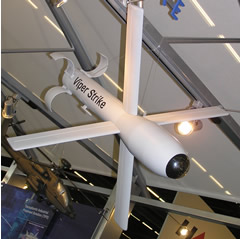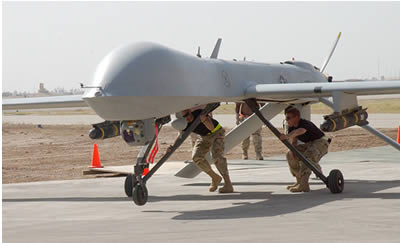The first weaponized UAVs were armed with standard munitions, meeting payload weight restrictions of existing unmanned vehicles. At that time, the Lockheed Martin Hellfire II missile was found to be the most suitable weapon for such roles. However, in a parallel path, the US Air Force and Army have been evaluating other weapons, including the Northrop Grumman BAT munition and its derivatives, as well as other types. Among the weapons considered for testing were two Israeli weapons, the IAI/MBT Lahat laser guided missiles, and RAFAEL Spike LR electro-optical guided missiles, both are believed to have been deployed with UAVs.
 In the past, standard missiles and gravity dropped weapons were found inadequate for employment with UAVs. For example, the Hellfire, designed for launching from manned platforms, did not have adequate off-boresight flexibility to acquire unexpected target,s therefore limiting engagement profiles and increasing the potential for collateral damage. Launch signature and range have limited its suitability for surprise attacks. The stealthy, acoustically guided BAT proved useless for low intensity warfare, since typical target acoustics can hardly be defined in adequate resolution for an attack. The weapon was therefore modified with a new semi-active laser homing device. Designated Viper-Strike, it retained the Bat’s vertical dive capability, demonstrating excellent precision kill while reducing collateral damage. Few of these weapons are currently deployed in Iraq, flying on Hunter UAVs. Northrop Grumman is reportedly making efforts to reduce the weight of the Viper Strike to 11.3 kg, thus making it suitable for the 168 kg AAI RQ-7B Shadow 200. The new AGM-114P Hellfire version has already been optimized for the Predator UAV. Among the modifications are increased weapon engagement zone (WEZ), enabling the seeker to acquire targets off-boresight up to 90 degrees to each side. These missiles can be released from higher altitude (10,000 to 25,000 ft), eliminating the need to descend to lower altitude prior to weapon release. The AGM-114P was cleared for service in early 2005.
In the past, standard missiles and gravity dropped weapons were found inadequate for employment with UAVs. For example, the Hellfire, designed for launching from manned platforms, did not have adequate off-boresight flexibility to acquire unexpected target,s therefore limiting engagement profiles and increasing the potential for collateral damage. Launch signature and range have limited its suitability for surprise attacks. The stealthy, acoustically guided BAT proved useless for low intensity warfare, since typical target acoustics can hardly be defined in adequate resolution for an attack. The weapon was therefore modified with a new semi-active laser homing device. Designated Viper-Strike, it retained the Bat’s vertical dive capability, demonstrating excellent precision kill while reducing collateral damage. Few of these weapons are currently deployed in Iraq, flying on Hunter UAVs. Northrop Grumman is reportedly making efforts to reduce the weight of the Viper Strike to 11.3 kg, thus making it suitable for the 168 kg AAI RQ-7B Shadow 200. The new AGM-114P Hellfire version has already been optimized for the Predator UAV. Among the modifications are increased weapon engagement zone (WEZ), enabling the seeker to acquire targets off-boresight up to 90 degrees to each side. These missiles can be released from higher altitude (10,000 to 25,000 ft), eliminating the need to descend to lower altitude prior to weapon release. The AGM-114P was cleared for service in early 2005.
RAFAEL’s family of electro-optically guided missile, known as the Electro-Optically guided Spike is also proposed for weaponized UAV applications. It was publicly unveiled on UAVs when proposed by Sagem to arm their Sperwer B UAV for demonstrations for the French military. The French study required the UAV to be capable of delivering high terminal precision, especially in asymmetric conflicts, and maintain the controller in the loop from launch to impact in order to minimize operating risks. Two versions of Spike are proposed for airborne applications – the Spike LR, and extended range version (Spike ER), which can be fitted with blast-penetration warhead, designed to inflict maximum lethality inside buildings or vehicles but minimize collateral damage to the surrounding area. Utilizing a fiber-optical link, Spike offers unique fire and forget or fire-observe and update operating modes either autonomous guidance or maintaining a “man in the loop” option throughout the missile’s flight, as the missile relays the scene viewed by it’s seeker, enabling the controller to accurately select the point of impact or abort the mission when the conditions are not matching the rules of engagement (for example, presence of civilians). IMI is also working on reduced lethality warheads, designed to optimize the terminal effect against buildings, vehicles and other soft targets, characteristic of urban environment.
A similar trend is taking place in Europe. MBDA is developing a technology demonstrator, proposed as a follow-on to the HOT system, currently known as the Missile de Combat Terrestre (MCT), which could be utilized in the future for armed UAVs. The new missile will be able to engage targets at Non-Line Of Sight (NLOS) mode, where the missile’s seeker does not have to be aimed at the target before launch. The company is developing several variants for the missile, including medium and long range versions with range of up to 8 km and turbo-jet powered extended range versions, with a maximum range of 100km. The weapon considered for the missile will include “multi-effect” warhead, making it effective against a broad target set, including fortified constructions, bunkers, armored vehicles and soft targets. The warhead could be equipped with a programmable lethality package to create “scalable” effect, tailored for specific operating scenarios.
Read additional parts of this article:
- Smart Weapons for UAVs
- Weaponized UAVs
- Smart Weapons for UAVs
- Evolution of UAV Employed Missiles
- Lightweight Weapons for Autonomous Platforms
- Gravity Dropped Munitions for UAVs
- Targeting at the pixel
- Loitering Autonomous Weapons
- Grouping in Constellations
- Empowered by the Swarm
- Weaponizing Unmanned Combat Helicopters


















